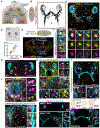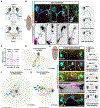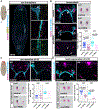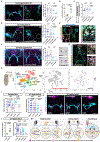Muscle and neuronal guidepost-like cells facilitate planarian visual system regeneration
- PMID: 32586989
- PMCID: PMC8128157
- DOI: 10.1126/science.aba3203
Muscle and neuronal guidepost-like cells facilitate planarian visual system regeneration
Abstract
Neuronal circuits damaged or lost after injury can be regenerated in some adult organisms, but the mechanisms enabling this process are largely unknown. We used the planarian Schmidtea mediterranea to study visual system regeneration after injury. We identify a rare population of muscle cells tightly associated with photoreceptor axons at stereotyped positions in both uninjured and regenerating animals. Together with a neuronal population, these cells promote de novo assembly of the visual system in diverse injury and eye transplantation contexts. These muscle guidepost-like cells are specified independently of eyes, and their position is defined by an extrinsic array of positional information cues. These findings provide a mechanism, involving adult formation of guidepost-like cells typically observed in embryos, for axon pattern restoration in regeneration.
Copyright © 2020 The Authors, some rights reserved; exclusive licensee American Association for the Advancement of Science. No claim to original U.S. Government Works.
Conflict of interest statement
Figures






Comment in
-
Guide cells help navigate axon regeneration.Science. 2020 Jun 26;368(6498):1428-1429. doi: 10.1126/science.abc8066. Science. 2020. PMID: 32587008 No abstract available.
References
-
- Hutter H, Extracellular cues and pioneers act together to guide axons in the ventral cord of C. elegans. Development 130, 5307–5318 (2003). - PubMed
-
- Klose M, Bentley D, Transient pioneer neurons are essential for formation of an embryonic peripheral nerve. Science 245, 982–984 (1989). - PubMed
-
- Pike SH, Melancon EF, Eisen JS, Pathfinding by zebrafish motoneurons in the absence of normal pioneer axons. Development 114, 825–831 (1992). - PubMed
Publication types
MeSH terms
Grants and funding
LinkOut - more resources
Full Text Sources

